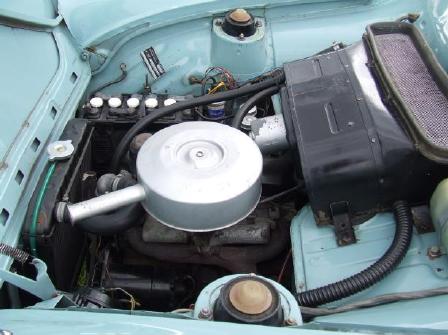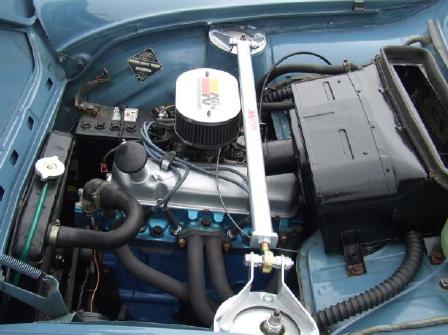| The
“All New Ford Anglia 105E ” of 1959 not
only had an attractive, new and unique body
style, it also sported a new four cylinder
overhead valve (OHV) type engine with a cast iron
cylinder head and block. This new engine finally
allowed Ford to break away from the old side
valve units, which had powered the previous 100E
small car range. The Anglia 105E Engine
featured overhead valves and
“over-square” dimensions with bore and
stroke measurements of 80.963mm x 48.412mm
respectively. The new engine had a cubic capacity
of 996.6cc and developed 39bhp at 5000 rpm, which
pushed the new Anglia along at a respectable
speed for 1959.

In addition to its
“over-square” cylinder dimensions, a
further unusual feature (for the time) of the
engine was an externally mounted combined oil
filter/pump unit designed to facilitate efficient
low-cost production.
By
leaving the bore unchanged and extending the
stroke, Ford developed a larger engine for the
Anglia to compete with its rivals at the time.
This new engine had a capacity of 1200cc and the
Anglia became known as the Anglia 123E. This new
engine also found a home in the Mk1 and early M2
Ford Cortina’s.


Specifications
of the 997cc and 1198cc Engines.
| 997 cc
engine |
Specifications |
| Type |
4-cylinder in line
overhead valve type |
| Bore |
3.1875 in (80.963
mm) |
| Stroke |
1.906 in (48.412
mm) |
| Cubic Capacity |
60.84 cu in (996.6
cc) |
| Compression Ratio |
8.9 to 1 Standard.
For Premium Grade Fuel
7.5 to 1 Optional. For Regular Grade Fuel |
| Cylinder Head |
Detachable cast
iron type. Fully machined combustion
chambers. |
| Valves |
Vertical overhead
type, push rod operated |
| Valve Clearance |
0.010 in (0.254 mm)
inlet
0.017 in (0.432 mm) exhaust
Normal running temperature |
| Firing Order |
1, 2, 4, 3 |
| Maximum Brake Horse
Power |
39 at 5,000 RPM
(8.9 C.R) |
| (Nett) |
37 at 5,000 RPM
(7.5 C.R) |
| Maximum Torque |
52.85 lb ft at
2,700 RPM (8.9 C.R) |
| (Nett) |
50.43 lb ft at
2,700 RPM (7.5 C.R) |

| 1198 cc
engine |
Specifications |
| Type |
4-cylinder in line
overhead valve type |
| Bore |
3.1875 in (80.963
mm) |
| Stroke |
2.29 in (58.17 mm) |
| Cubic Capacity |
73.09 cu in (1,198
cc) |
| Compression Ratio |
8.7 to 1 Standard.
For Premium Grade Fuel
7.3 to 1 Optional. For Regular Grade Fuel |
| Cylinder Head |
Detachable cast
iron type. Fully machined combustion
chambers. |
| Valves |
Vertical overhead
type, push rod operated |
| Valve Clearance |
0.010 in (0.254 mm)
inlet
0.017 in (0.432 mm) exhaust
Normal running temperature |
| Firing Order |
1, 2, 4, 3 |
| Maximum Brake Horse
Power |
48.5 at 4,800 RPM
(8.7 C.R) |
| (Nett) |
46 at 4,800 RPM
(7.3 C.R) |
| Maximum Torque |
63 lb ft at 2,700
RPM (8.7 C.R) |
| (Nett) |
60 lb ft at 2,700
RPM (7.3 C.R) |

By
continuing along this path, Ford extended the
stroke even more to create the 1340cc and 1500cc
engines, which would ultimately be used in its
new car range at the time.
The
engine is now referred to as the pre-crossflow,
to differentiate it from the later crossflow
engines used in the Anglia’s successor, the
Escort. The names refer to the location of the
inlet and exhaust manifold on each engine. The
105E Engine or pre-crossflow, have both the inlet
and exhaust manifolds on the same side, whereas
the crossflow has the inlet and exhaust manifolds
on opposite sides of the engine.
Shown
below is a Crossflow Engine retro fitted into an
Anglia

Other
Manufacturers (including Ford) saw the potential
of the Ford Anglia 105E Engine and used it as the
motive power within their own specialist
bodywork. These vehicles ranged from small two
seater sports cars to four door saloons.
Continuing on this
theme the Ford Anglia 105E Engine was marinised
by various Companies and used as inboard motors to power motor
cruisers
and riverboats.
Over the years,
some people have found the original 997cc a
little on the slow side and have found different
ways (and engines) to propel the little Anglia
along at a quicker pace.

(Article Copyright © MellY
Designs - Please do not Reproduce without
Permission)
|

